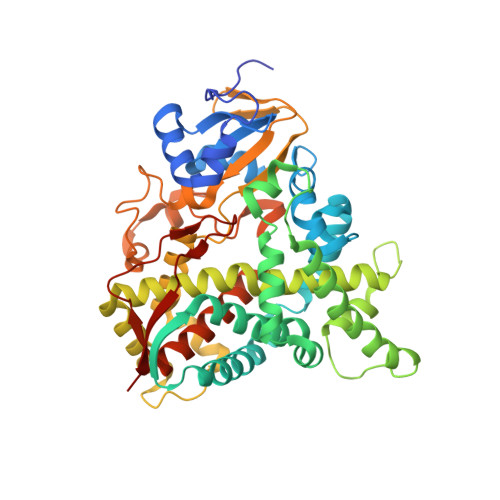Oxygen-18 Labeling Reveals a Mixed Fe-O Mechanism in the Last Step of Cytochrome P450 51 Sterol 14 alpha-Demethylation.
McCarty, K.D., Tateishi, Y., Hargrove, T.Y., Lepesheva, G.I., Guengerich, F.P.(2024) Angew Chem Int Ed Engl 63: e202317711-e202317711
- PubMed: 38206808
- DOI: https://doi.org/10.1002/anie.202317711
- Primary Citation of Related Structures:
8SS0 - PubMed Abstract:
The 14α-demethylation step is critical in eukaryotic sterol biosynthesis, catalyzed by cytochrome P450 (P450) Family 51 enzymes, for example, with lanosterol in mammals. This conserved three-step reaction terminates in a C-C cleavage step that generates formic acid, the nature of which has been controversial. Proposed mechanisms involve roles of P450 Compound 0 (ferric peroxide anion, FeO 2 - ) or Compound I (perferryl oxygen, FeO 3+ ) reacting with either the aldehyde or its hydrate, respectively. Analysis of 18 O incorporation into formic acid from 18 O 2 provides a means of distinguishing the two mechanisms. Human P450 51A1 incorporated 88 % 18 O (one atom) into formic acid, consistent with a major but not exclusive FeO 2 - mechanism. Two P450 51 orthologs from amoeba and yeast showed similar results, while two orthologs from pathogenic trypanosomes showed roughly equal contributions of both mechanisms. An X-ray crystal structure of the human enzyme showed the aldehyde oxygen atom 3.5 Å away from the heme iron atom. Experiments with human P450 51A1 and H 2 18 O yielded primarily one 18 O atom but 14 % of the formic acid product with two 18 O atoms, indicative of a minor contribution of a Compound I mechanism. LC-MS evidence for a Compound 0-derived Baeyer-Villiger reaction product (a 14α-formyl ester) was also found.
- Department of Biochemistry, Vanderbilt University School of Medicine, Nashville, TN 37232-0146, USA.
Organizational Affiliation:


















